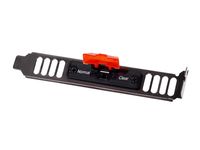Silverstone Releases Clear CMOS: The External CMOS Reset Switch
Nobody enjoys having to open up the computer case and possibly move components just to reach that tiny and often poorly placed CMOS reset jumper cap every time an overclock fails. Silverstone has recently released a solution to the problem that has frustrated overclockers for so long - an external CMOS reset switch to replace the jumper cap known unsurprisingly as Clear CMOS.
The reset switch is mounted on a bracket which simply slots into an available space on your expansion card backplate. For most people this is far more convenient than having to open up the case. Others may find having to reach around to the back of their case just as annoying, depending on where the case is situated.
The switch itself is quite small and is therefore easy to damage or activate if bumped. Silverstone added a red cover which protects the switch and prevents an accidental reset. The switch is connected to the CMOS reset jumper with wires similar to those used by the front panel switches, and therefore replaces the original jumper cap. The bracket is essentially a modified version of the company’s Aero Slots expansion slot covers and has four ventilation holes on either side of the switch.
The concept of an external CMOS clear switch is not a new one. Motherboard manufacturers such as Universal abit have used them for some time, often placing them on the motherboard backplate. These switches are often small, flimsy and uncovered so that they can be activated by accident.
Pricing and availability for Clear CMOS is not yet known.
Get Tom's Hardware's best news and in-depth reviews, straight to your inbox.
-
cliffro Quite surprisingly, I have not had to reset my cmos in quite some time...when I ran into an overclock that my system didn't like, my motherboard reset itself. Thank you Gigabyte.Reply
Its a nice idea but in the world of Dual Bios' and such its not as sorely needed as it used to be. And knowing Silverstone it will probably not be cheap. -
cliffro I didn't actually mean to give it a negative rating...unless they consider neutral negative....i'm not much of a commenter so i never noticed the rating buttons..... its a good article, but the product isn't ground breaking or even desperately needed.Reply -
simple yet effective tool.Reply
But maybe becoming a useless feat now that CoreI7 is being released with lots 'easier'(according to MS) overclocking abilities? -
KITH interesting idea but why not have an option to have it on the front of the case? Also why ventilation holes? That will make the case louder.Reply -
JohnnyLucky I don't know about having to get all the way back to a slot cover at the bottom rear of a case. Could wind up being a pain in the butt. I guess it just depends on how difficult it will be to get to the switch. I like the one I got from Frozen CPU better. I have a lot more freedom of choice in deciding where to mount the switch. I am going to mount my switch to the top of the rear panel. I can reach the switch without any difficulty and it will be hidden from view.Reply
There is an inherent problem with both switches. In order to properly clear/reset CMOS, power to the psu has to be shut off. That means pulling the plug either from the psu or an electrical outlet. I mounted the psu in the bottom rear of the case. I am resigned to the fact that I will have to reach under the desk and pull the plug from the surge protector. That is easier than trying to reach the bottom rear of the case. -
croc I built one years ago... A jumper cap with two wires plugged in leading to a spdt momentary sw. mounted on a spare slot cover. $ 5.00 AUD for the switch? Probably less....Reply
With new MB's and dual bios, not much need, but one can get one's primary bios so twisted that it just refuses to post. Belts and suspenders... 4 MB's later, its still plugged in. -
gsteacy I have a single BIOS motherboard. I find it usually recovers from a bad overclock pretty well, but it doesn't like it when the memory timings are too tight. I usually need to clear the CMOS then.Reply -
seatrotter ReplyThese switches are often small, flimsy and uncovered so that they can be activated by accident.
Why does it seem like that it is intended to be accidentally activated? Shouldn't it appear something like:
These switches are often small, flimsy and uncovered, making the motherboard's CMOS prone to accidental resets.
-
Numerical I can see the benefit in this solely for those who frequently screw up at overclocking, but for those of us with our PC's under lock and key, it makes the system almost hacker friendly.Reply
